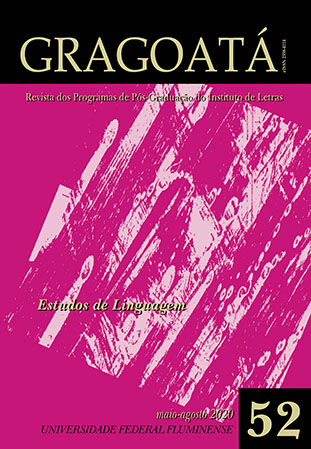A rede construcional do esquema focalizador [que só] no português brasileiro
DOI :
https://doi.org/10.22409/gragoata.v25i52.40830Mots-clés :
Gramática de Construções. Construções Focalizadoras. [Que só].Résumé
Os sentidos da linguagem são constituídos subjetivamente nas práticas de comunicação, no âmbito de domínios semânticos e pragmáticos. Nesta perspectiva, a gramática pode ser caracterizada como uma rede de construções em constante transformação, cujas análises levam ao extremo a indissociável relação entre forma e sentido constituída no uso da língua. Por sua vez, a mudança linguística é inerente ao funcionamento da língua, ocorrendo de forma gradiente, radial e indissociável dos contextos de uso. Dessa maneira, neste artigo, tendo por base uma abordagem construcional, fundamentada nas proposições da Gramática de Construções, representada especialmente por Langacker (2009), Goldberg (1995; 2006), Bybee (2006; 2010; 2015), Traugott e Dasher (2005), Traugott (2008), Traugott e Trousdale (2010; 2013), Diessel (2015), Oliveira e Rosário (2015), dentre outros, analisamos o esquema construcional focalizador [que só] no português brasileiro contemporâneo. A focalização é uma construção, uma entidade abstrata constituída por pareamentos de forma e sentido e pressupõe os domínios da ênfase, do contraste e da intensificação de conhecimentos de mundo compartilhados pelos falantes. As construções [que só] exercem função pragmática de foco, e sua constituição decorre da junção de duas estruturas focalizadoras recorrentes na língua portuguesa. Definimos os subesquemas e os contextos de uso das microconstruções derivadas do esquema [que só] nos níveis semântico, sintático e discursivo-pragmático. São descritos, também, os graus de abstratização dos usos das focalizadoras. Os resultados demonstram superposição dos domínios da comparação e da intensificação, revelando uma espécie de superesquema focalizador no português brasileiro contemporâneo.
Téléchargements
Téléchargements
Publiée
Numéro
Rubrique
Licence
AUTORIZAÇÃO
Autores que publicam em Gragoatá concordam com os seguintes termos:
Os autores mantêm os direitos e cedem à revista o direito à primeira publicação, simultaneamente submetido a uma licença Creative Commons Atribuição 4.0 Internacional (CC BY 4.0), que permite o compartilhamento por terceiros com a devida menção ao autor e à primeira publicação pela Gragoatá.
Os autores podem entrar em acordos contratuais adicionais e separados para a distribuição não exclusiva da versão publicada da obra (por exemplo, postá-la em um repositório institucional ou publicá-la em um livro), com o reconhecimento de sua publicação inicial na Gragoatá.
A Gragoatá utiliza uma Licença Creative Commons - Atribuição CC BY 4.0 Internacional.











